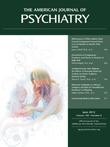T
o the E
ditor: In the meta-analysis by Fusar-Poli et al. (
1) appearing in the March 2012 issue, the authors contend that an overall 14% greater striatal dopamine transporter binding in the brains of adults with ADHD was caused by previous exposure to stimulant medications. Based on significant errors in the assignment of treatment status, this conclusion is unsupportable. In their Table 1, the ADHD treatment status of the studies defines “drug-free” as all subjects (100%) having previous exposure, and Figure 4 illustrates a metaregression analysis based on this critical variable—previous treatment status—as derived from the primary source manuscripts.
There are some contradictions with the primary source materials. Two of the studies that were identified as drug free (i.e., from previous medication exposure) in Figure 4 were drug naive. The subjects in the la Fougère et al. study (
2) were designated as “drug free” in Table 1, but ADHD subjects were drug naive. The second study is not explicitly identified in Figure 4 but can be inferred because 1) Figure 4 shows three studies in which all ADHD subjects had previous exposure, yet Table 1 lists only two studies in this category, and 2) Figure 4 shows four studies as drug naive, yet Table 1 lists five studies with drug-naive subjects. Table 1 lists the Dougherty et al. study (
3) as 100% previous exposure when, as indicated in a clarification published in
Lancet (
4), there was 67% exposure. The Volkow et al. study (
5) is listed and analyzed as if subjects were drug naive, but an earlier version of this Volkow et al. study (
6) stated, “Subjects were excluded if they had a prior history of more than 1 month of medication treatment for ADHD.” The Jucaite et al. study (
7) appears to fit the Figure 4 regression, as the three subjects with previous drug exposure appear to account for elevated mean dopamine transporter binding of ADHD subjects. Yet, the opposite conclusion can be drawn from the primary source manuscript, in which Figure 3 shows that ADHD subjects with previous medication exposure had lower average dopamine transporter binding (estimated 8 units) than drug-naive ADHD subjects (estimated 10 units). Thus, the Jucaite et al. data support the view that previous stimulant treatment is not associated with increased dopamine transporter binding but overall lower dopamine transporter binding.
If two of the inaccurately designated studies are shifted from the drug-free (100% previous treatment) to drug-naive category, the analysis, the slope of Figure 4, and the conclusions of the paper will change.
Finally, we noticed that Figure 1 shows typical positron emission tomography or single photon emission computed tomography probes for the dopamine transporter. It includes one probe (2β-carbomethoxy-3β-[4-fluorophenyl] tropane [CFT]) not used in the studies in this meta-analysis and excludes two (altropane and cocaine) that are used in the studies in this meta-analysis.

